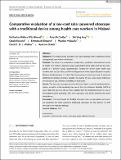Files in this item
Comparative evaluation of a low-cost solar powered otoscope with a traditional device among health care workers in Malawi
Item metadata
| dc.contributor.author | Balfour, Katharine | |
| dc.contributor.author | McCarthy, Amy | |
| dc.contributor.author | Hey, Shi Ying | |
| dc.contributor.author | Kousha, Obaid | |
| dc.contributor.author | Singano, Emmanuel | |
| dc.contributor.author | Mulwafu, Wakisa | |
| dc.contributor.author | Walker, David F. D. L. | |
| dc.contributor.author | Blaikie, Andrew | |
| dc.date.accessioned | 2021-06-11T09:30:16Z | |
| dc.date.available | 2021-06-11T09:30:16Z | |
| dc.date.issued | 2021-08 | |
| dc.identifier | 274584866 | |
| dc.identifier | 68e9a692-4910-4394-921c-748ba3723fa0 | |
| dc.identifier | 000659712500001 | |
| dc.identifier | 85107408329 | |
| dc.identifier.citation | Balfour , K , McCarthy , A , Hey , S Y , Kousha , O , Singano , E , Mulwafu , W , Walker , D F D L & Blaikie , A 2021 , ' Comparative evaluation of a low-cost solar powered otoscope with a traditional device among health care workers in Malawi ' , Laryngoscope Investigative Otolaryngology , vol. 6 , no. 4 , pp. 839-843 . https://doi.org/10.1002/lio2.601 | en |
| dc.identifier.issn | 2378-8038 | |
| dc.identifier.other | RIS: urn:05A792B3A6A9C36CAAE4668DDF861CA1 | |
| dc.identifier.other | ORCID: /0000-0001-7913-6872/work/95418596 | |
| dc.identifier.uri | https://hdl.handle.net/10023/23344 | |
| dc.description | Funding: Dorothy Miller Bursary Scheme - University of St Andrews Medical School. | en |
| dc.description.abstract | Objectives: To comparatively evaluate a low-cost otoscope with a traditional device among health care workers in Malawi. Methods: The study is a prospective, comparative, qualitative observational survey of health care worker's opinions using 5-point Likert rating scales and tick box categories in a 10-item survey questionnaire. Twenty-five mixed cadre health care workers from the Ear, Nose, and Throat Department of the Queen Elizabeth Hospital, Blantyre in Malawi were recruited. Outcomes measures used were ease of speculum attachment, handling, insertion, stability, the quality of view, color, build, brightness, overall ease of use, and their suitability for local work. Results: The low-cost otoscope scored statistically higher in overall combined performance, as well as in the remaining four out of the nine attributes. Notably, 54.2% of users rated the low-cost device more suitable than the traditional device for use in low-middle income countries, 25% were equivocal, and 20.8% preferred the traditional device. Conclusion: This study found the Arclight otoscope to be an appropriate and practical substitute for more expensive traditional otoscopes for the delivery of ENT services in low resource settings. Level of Evidence: N/A | |
| dc.format.extent | 5 | |
| dc.format.extent | 854934 | |
| dc.language.iso | eng | |
| dc.relation.ispartof | Laryngoscope Investigative Otolaryngology | en |
| dc.subject | Education | en |
| dc.subject | Health resources | en |
| dc.subject | Malawi | en |
| dc.subject | Otoscopes | en |
| dc.subject | Quality-adjusted life years | en |
| dc.subject | L Education | en |
| dc.subject | RA0421 Public health. Hygiene. Preventive Medicine | en |
| dc.subject | E-DAS | en |
| dc.subject | SDG 3 - Good Health and Well-being | en |
| dc.subject.lcc | L | en |
| dc.subject.lcc | RA0421 | en |
| dc.title | Comparative evaluation of a low-cost solar powered otoscope with a traditional device among health care workers in Malawi | en |
| dc.type | Journal article | en |
| dc.contributor.institution | University of St Andrews. School of Medicine | en |
| dc.contributor.institution | University of St Andrews. Infection and Global Health Division | en |
| dc.identifier.doi | 10.1002/lio2.601 | |
| dc.description.status | Peer reviewed | en |
This item appears in the following Collection(s)
Items in the St Andrews Research Repository are protected by copyright, with all rights reserved, unless otherwise indicated.

